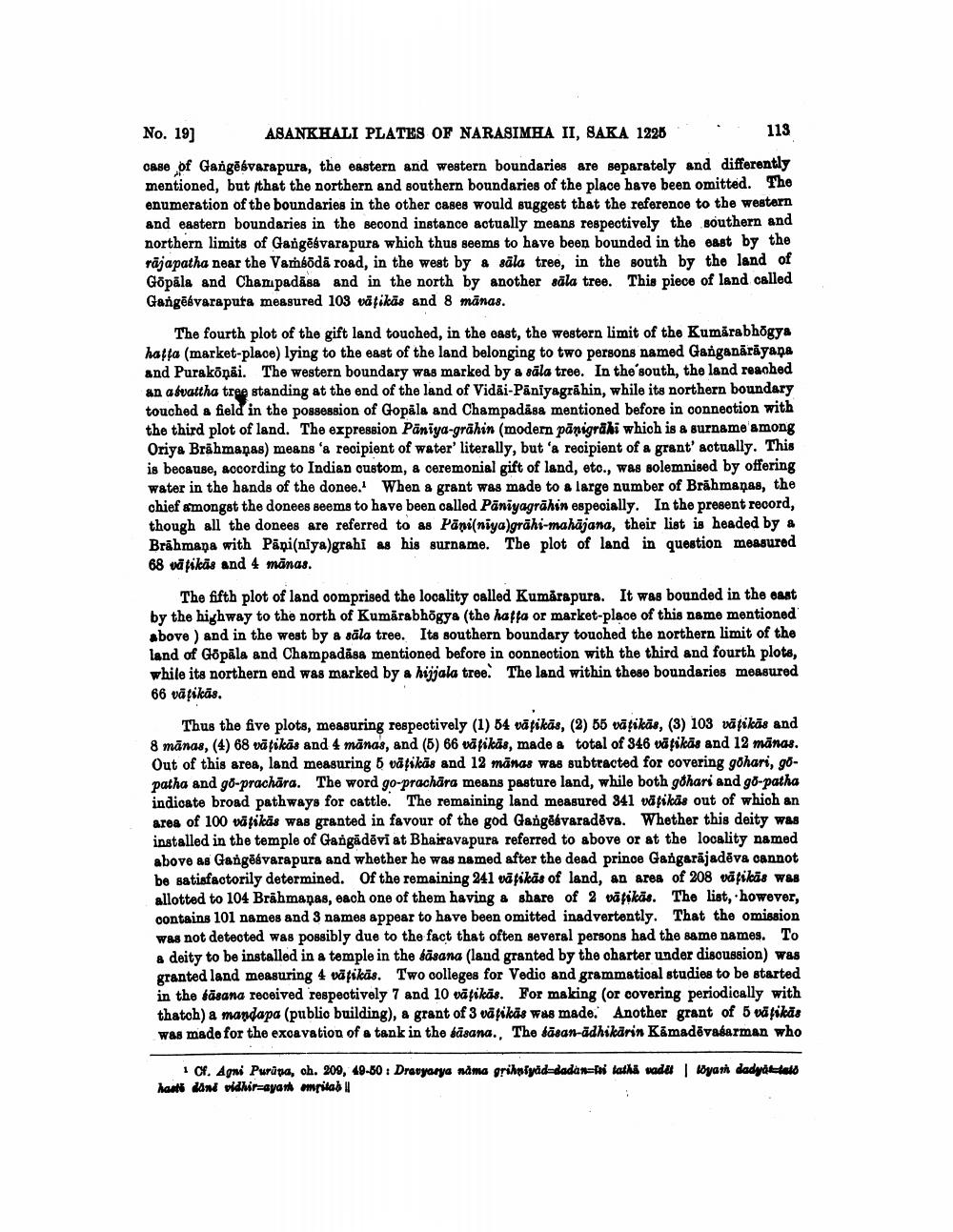________________
No. 19]
ASANKHALI PLATES OF NARASIMHA II, SAKA 1225
case of Gangesvarapura, the eastern and western boundaries are separately and differently mentioned, but that the northern and southern boundaries of the place have been omitted. The enumeration of the boundaries in the other cases would suggest that the reference to the western and eastern boundaries in the second instance actually means respectively the southern and northern limits of Gangesvarapura which thus seems to have been bounded in the east by the rajapatha near the Vaméödä road, in the west by a sala tree, in the south by the land of Gopala and Champadasa and in the north by another sala tree. This piece of land called Gangesvarapura measured 103 vātikās and 8 mānas.
113
The fourth plot of the gift land touched, in the east, the western limit of the Kumārabhogya hatta (market-place) lying to the east of the land belonging to two persons named Ganganarayana and Purakōnai. The western boundary was marked by a sala tree. In the south, the land reached an asvattha tree standing at the end of the land of Vidai-Paniyagrahin, while its northern boundary touched a field in the possession of Gopala and Champadasa mentioned before in connection with the third plot of land. The expression Päniya-grähin (modern panigrahi which is a surname among Oriya Brahmanas) means 'a recipient of water' literally, but 'a recipient of a grant' actually. This is because, according to Indian custom, a ceremonial gift of land, etc., was solemnised by offering water in the hands of the donee. When a grant was made to a large number of Brahmaņas, the chief amongst the donees seems to have been called Päniyagrähin especially. In the present record, though all the donees are referred to as Pani(niya)grähi-mahajana, their list is headed by a Brahmana with Pāņi(niya)grahi as his surname. The plot of land in question measured 68 vātikās and 4 mānas.
The fifth plot of land comprised the locality called Kumarapura. It was bounded in the east by the highway to the north of Kumarabhögya (the hafta or market-place of this name mentioned above) and in the west by a sala tree. Its southern boundary touched the northern limit of the land of Gopala and Champadasa mentioned before in connection with the third and fourth plots, while its northern end was marked by a hijjala tree. The land within these boundaries measured 66 vātikās.
Thus the five plots, measuring respectively (1) 54 vāţikās, (2) 55 vāṭikās, (3) 103 vātikās and 8 mānas, (4) 68 vātikās and 4 mānas, and (5) 66 vatikās, made a total of 346 vātikās and 12 mänas. Out of this area, land measuring 5 vatikās and 12 mānas was subtracted for covering gōhari, göpatha and go-prachara. The word go-prachara means pasture land, while both gohari and go-patha indicate broad pathways for cattle. The remaining land measured 341 väțikäs out of which an area of 100 välikäs was granted in favour of the god Gangesvaradeva. Whether this deity was installed in the temple of Gangadevi at Bhairavapura referred to above or at the locality named above as Gangesvarapura and whether he was named after the dead prince Gangarajadeva cannot be satisfactorily determined. Of the remaining 241 väțikäs of land, an area of 208 vātikās was allotted to 104 Brahmanas, each one of them having a share of 2 vātikās. The list, however, contains 101 names and 3 names appear to have been omitted inadvertently. That the omission was not detected was possibly due to the fact that often several persons had the same names. To a deity to be installed in a temple in the sasana (land granted by the charter under discussion) was granted land measuring 4 väțikās. Two colleges for Vedic and grammatical studies to be started in the sasana received respectively 7 and 10 vātikās. For making (or covering periodically with thatch) a mandapa (public building), a grant of 3 vātikas was made. Another grant of 5 välikās was made for the excavation of a tank in the sasana., The śäsan-adhikarin Kāmadēvasarman who
1 Cf. Agni Purana, ch. 209, 49-50: Dravyarya näma gṛihniyäd-dadan=îti tathā vadēt | böyam dadyä tais hasti dané vidhir-ayam emritab ||




